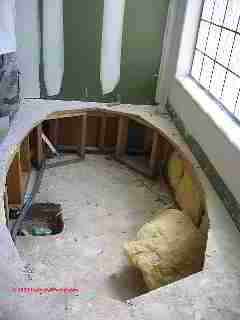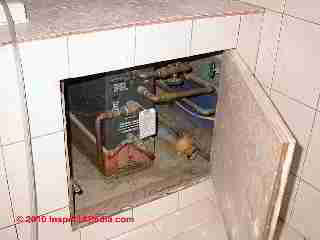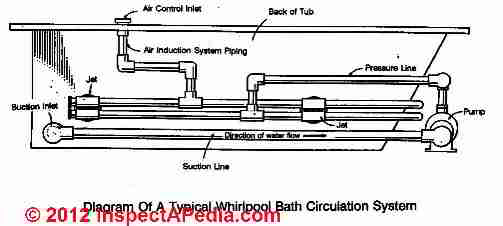 How to intall jetted tubs
How to intall jetted tubs
Installation recommendations for Whirlpools & Spas or Tubs: Best Practices
- POST a QUESTION or COMMENT about how to install whirlpool bath tubs, spas, jacuzzis
Jetted tub installation best practices:
This article discusses best installation practices for jetted tubs, soaking tubs, whirlpool baths and spas.
A list of kitchen and bath product manufactures and sources is included. This article series discusses current best design practices for kitchens and bathrooms, including layout, clearances, work space, and accessible kitchen and bathroom layout, clearances, turning space, grab bars, controls, etc.
We include advice on choosing and installing kitchen countertops, cabinets, and kitchen or bathroom flooring, sinks, and other plumbing fixtures and fixture controls such as faucets.
InspectAPedia tolerates no conflicts of interest. We have no relationship with advertisers, products, or services discussed at this website.
- Daniel Friedman, Publisher/Editor/Author - See WHO ARE WE?
Installation Recommendations for Whirlpools & Spas or Tubs
This article includes excerpts or adaptations from Best Practices Guide to Residential Construction (Steve Bliss, J Wiley & Sons) , by Steven Bliss, courtesy of Wiley & Sons. As explained in Chapter 6:
The simplest and least expensive installation is into a two-wall or three-wall cove with factory-supplied skirts to conceal the mechanicals. However, many customers prefer the look of a drop-in model with a custom tile surround (see Figure 6-53).
With either type of installation, it is critical that the weight of the tub be supported by the base, not the lip. With larger tubs, often holding 50 to 80 gallons of water (at 8 pounds per gallon), the framing and subfloor may need to be reinforced to support the total weight of the tub, water, and bathers. A larger water heater may also be needed.
The most common method to support the tub bottom and dampen vibration is to set the tub onto several small mounds of wet plaster or mortar mix that compress and conform to the shape of the tub bottom as it is installed. A non shrinking grout such as Sonogrout 10K (Sonneborn) is best since it will not leave gaps as it dries.
Partially filling the tub with water until the mortar sets will ensure a good fit. Many contractors recommend using mortar even with units including “self-leveling” bases, which are designed to sit on a level subfloor with no additional support.
A few tubs are designed with individual bearing points molded into the bottom of the tub. With this type, it is important to make sure that the bearing points fall on joists or solid blocking. Solid bridging should also be added to help distribute the load to the surrounding joists.
Access Panel Designs for Whirlpool Baths, Jetted Tubs, Spas
With a custom-built surround, it is necessary to leave an access panel. Although access to the mechanicals is rarely needed, it should not require tearing apart the tile surround.
A simple approach is to tile the access panel, hang it with magnets, and caulk the joint between the access panel and surrounding tiles. If access is necessary, the caulk can be slit with a knife and the panel removed.
Where the tub rim meets tile at a wall or the top of the
surround, use a flexible caulk rather than grout, which will
crack as the tub flexes, and expands and contracts with
temperature changes.
Question: jetted tub elevation for basement installation
6/16/2014 Anonymous said:
Is it necessary to raise a jet tub installed in the basement by 12 inches to allow for drainage?
Reply:
Anon,
You have two general approaches to drainage options when installing a jetted tub or any other plumbing system in a building basement:
IF the outlet of the plumbing fixture trap is sufficiently high above the point at which the fixture drain connects to a building drain then the fixture can drain by gravity. Sometimes we gain a little height at the fixture to make a drain line work by building a platform onto which the toilet, tub, or shower is installed, allowing it to drain by gravity. You need between 1/8" and 1/4" of slope per foot over the entire run of the plumbing drain.
IF the fixture outlet trap is too low to drain by gravity and building a platform is not practical, for example when the building drain exits high on the basement wall, you'll need to install an ejector pump and check valve so that drainage from the fixture can be lifted to the height of the building drain. If a toilet also empties into the ejector pump then a grinder pump is needed.
Where to Get Instructions for Specific-Brands of Jetted and Soaking Tubs
- American Standard www.americanstandard-us.com
- Aqua Glass Corp. www.aquaglass.com
- Aquatic Industries www.aquaticwhirlpools.com
- Bains Oceana Baths www.bainsoceaniabaths.com
- Eljer Plumbingware www.eljer.com
- Hydro Systems www.hydrosystem.com
- Jacuzzi Whirlpool Baths www.jacuzzi.com
- Kohler Co. www.kohler.com
- Lasco Bathware www.lascobathware.com
- Maax www.maax.com
- MTI Whirlpools www.mtiwhirlpools.com
- - Adapted with permission from Best Practices Guide to Residential Construction (Steve Bliss, J Wiley & Sons) .
...
Continue reading at HOT TUB SPA WHIRLPOOL OPERATION & REPAIR or select a topic from the closely-related articles below, or see the complete ARTICLE INDEX.
Or see
BATHROOM DESIGN and also BATHROOM DESIGN, ACCESSIBLE
BATHROOM VENTILATION CODES SPECS
PLUMBING FIXTURES, KITCHEN, BATH - home
TUBS & TUB REPLACEMENTS or RELINERS
SPAS WHIRLPOOLS SOAKING & JETTED TUBS - home
Suggested citation for this web page
SPAS, WHIRLPOOLS, INSTALLATION at InspectApedia.com - online encyclopedia of building & environmental inspection, testing, diagnosis, repair, & problem prevention advice.
Or see this
INDEX to RELATED ARTICLES: ARTICLE INDEX to BATH & KITCHEN
Or use the SEARCH BOX found below to Ask a Question or Search InspectApedia
Ask a Question or Search InspectApedia
Try the search box just below, or if you prefer, post a question or comment in the Comments box below and we will respond promptly.
Search the InspectApedia website
Note: appearance of your Comment below may be delayed: if your comment contains an image, photograph, web link, or text that looks to the software as if it might be a web link, your posting will appear after it has been approved by a moderator. Apologies for the delay.
Only one image can be added per comment but you can post as many comments, and therefore images, as you like.
You will not receive a notification when a response to your question has been posted.
Please bookmark this page to make it easy for you to check back for our response.
Our Comment Box is provided by Countable Web Productions countable.ca
Citations & References
In addition to any citations in the article above, a full list is available on request.
- Best Practices Guide to Residential Construction, by Steven Bliss. John Wiley & Sons, 2006. ISBN-10: 0471648361, ISBN-13: 978-0471648369, Hardcover: 320 pages, available from Amazon.com and also Wiley.com. See our book review of this publication.
- Our recommended books about building & mechanical systems design, inspection, problem diagnosis, and repair, and about indoor environment and IAQ testing, diagnosis, and cleanup are at the InspectAPedia Bookstore. Also see our Book Reviews - InspectAPedia.
- Best Practices Guide to Residential Construction, by Steven Bliss. John Wiley & Sons, 2006. ISBN-10: 0471648361, ISBN-13: 978-0471648369, Hardcover: 320 pages, available from Amazon.com and also Wiley.com. See our book review of this publication.
- In addition to citations & references found in this article, see the research citations given at the end of the related articles found at our suggested
CONTINUE READING or RECOMMENDED ARTICLES.
- Carson, Dunlop & Associates Ltd., 120 Carlton Street Suite 407, Toronto ON M5A 4K2. Tel: (416) 964-9415 1-800-268-7070 Email: info@carsondunlop.com. Alan Carson is a past president of ASHI, the American Society of Home Inspectors.
Thanks to Alan Carson and Bob Dunlop, for permission for InspectAPedia to use text excerpts from The HOME REFERENCE BOOK - the Encyclopedia of Homes and to use illustrations from The ILLUSTRATED HOME .
Carson Dunlop Associates provides extensive home inspection education and report writing material. In gratitude we provide links to tsome Carson Dunlop Associates products and services.




